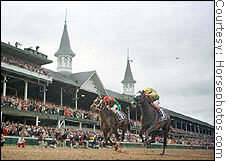
NEW YORK (CNN/Money) -
The first sporting event I ever attended was a horse race.
My late grandmother would bring my brother and me to the track with her when we were still dwarfed by the jockeys, and have us look at the horses in the paddock and pick the ones we liked. Among the life lessons I learned from my grandmother is, "Always bet long shots across the board," meaning place bets that will pay off for either a first, second or third place finish.
Agnes Isidore loved all types of gambling. And while she bet on different sports and eventually played the state lottery when it came, she always loved her horses the best of all her bets.
But unfortunately for the racing industry, I haven't been to the track since the last time I went with her more than a decade ago, shortly before she fell ill. And the aging of the race fan is an unfortunate fact for the sport that will be difficult if not impossible for it to turn around.
 |
|
| The Kentucky Derby is still popular, but the sport may be in the home stretch due to an aging fan base. |
The National Thoroughbred Racing Association's own figures show that the average age of its 3 million committed fans, those who attend multiple races every year, is now 55 years old. Despite a $30 million a year promotional campaign by the association and member tracks aimed at younger and female fans, my guess is that 10 years from now the average age will be close to 65.
The more casual race fans who attend a race once or twice a year, which the NTRA campaign is focused on reaching, have an average age of 45 - hardly generation X.
In the decade before I was born in 1960, horse racing was one of the nation's most popular sports. What happened? Look in virtually any living room. It's television.
Other sports embraced the medium in the 1960s. Horse racing virtually shunned it, worried that if people watched at home, they wouldn't come to the track and wager. And any race fan can tell you that death is the normal outcome when a horse stumbles badly and comes up lame in a race, as the sport did in this instance.
"It cost them the interest of every generation that came of age after 1960," said Eugene Christiansen of Christiansen Capital Advisors, an expert on gaming. "If it's not on that box, it's not in people's consciousness."
The Kentucky Derby which runs Saturday is the exception to that - the sports' one high profile event on television. It drew a respected 9.3 percent of U.S. households last year, and about a quarter of all viewers watching television at that time.
| |
 SportsBiz
SportsBiz
| |
| | |
| | |
|
But that halted a series of declining ratings for the program, and it was mostly helped by moving to NBC, meaning it no longer had to compete with the National Basketball Association playoffs. Next year, when the NBA moves to the ABC/ESPN family from NBC, it could find itself left behind in the dust once again.
The sport is trying to play catch-up with its television coverage, but it's like a long-shot trying to catch up after falling out of the gate. This year it will broadcast a total of 180 hours of races on both broadcast and cable networks, or well less than 1 percent of sports shown on television, putting it far behind such broadcast powerhouses as hockey, soccer and arena football. Ratings for anything other than the Triple Crown races are dismal.
Part of the reason is that it is so much easier for people to place other bets today than in the past, when racing held almost a monopoly on legal gaming in United States. There are casinos and riverboat gambling popping up all the time, and it's tough to buy a gallon of milk without being offered a $1 chance at millions in a state-sponsored lottery.
| |
 Related stories and columns
Related stories and columns
| |
| | |
| | |
|
The sport's officials argue that interactive television and in-home gaming will give it an advantage to increase revenue and interest once again. The Television Games Network, owned by Gemstar-TV Guide International Inc. (GMST: Research, Estimates) is pushing in-home gaming in a pilot program in California, which now lets viewers bet by phone or Internet and will eventually allow them to wager using an interactive TV remote control.
But spreading the in-home pari-mutuel wagering faces many legal challenges, as well as the fact that the base of horse racing fans may be too small to attract the attention of cable operators.
Interactive TV has continued to be more promise than reality in the United States, and a few million horse racing fans spread across the country aren't likely to turn that around. The older fan base also isn't generally known as early-adopters of new technology. I have trouble picturing my grandmother logging onto the Internet to bet, let alone using an interactive remote control.
So if you want to bet on horse racing finding the younger crowd it needs to survive, my grandmother's advice undoubtedly would be to bet win, place and show. Because it's definitely a long shot.

|

